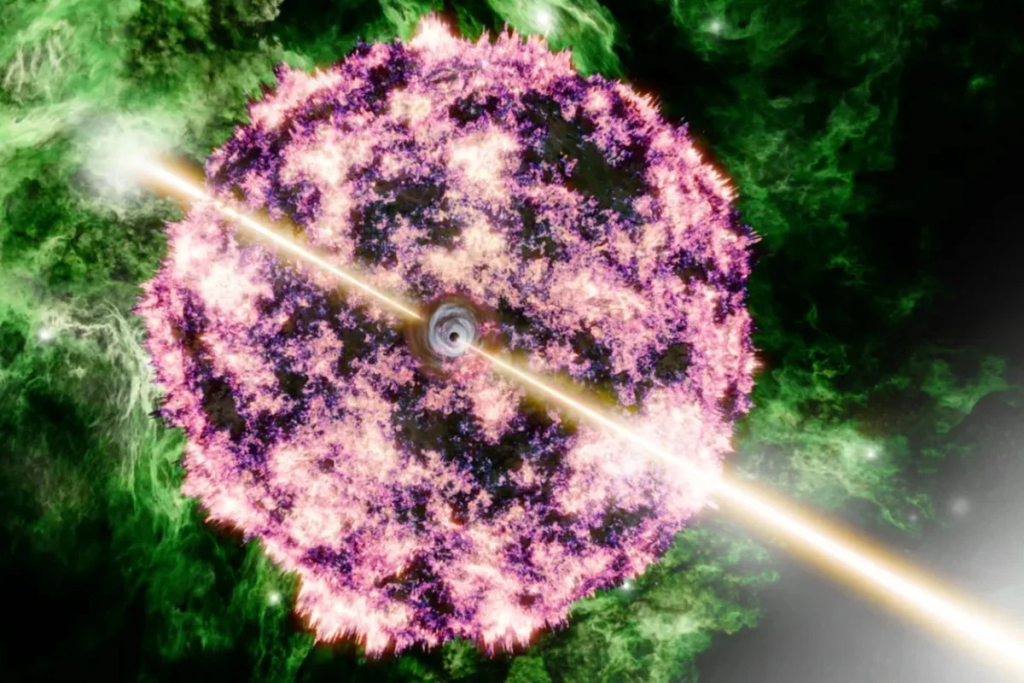
After what may have been the biggest cosmic explosion since the Big Bang, matter and antimatter collided at nearly the speed of light, annihilating each other and releasing their energy back into the universe, a new study from China suggests.
By analyzing data from Chinese and U.S. space telescopes, a team led by researchers from the Chinese Academy of Sciences (CAS) has identified a spectral line with energy levels peaking at 37 million electron volts (MeV) during an exceptionally powerful gamma-ray burst, now known as the Brightest Ever, or BOAT.
Because BOAT was composed of several high-energy particles, including electrons and their antimatter counterparts, positrons, it is likely that these particles underwent annihilation, releasing gamma-ray photons and generating the observed spectral line, they reported in the journal Science China: Physics, Mechanics & Astronomy last week.
“Our findings have important and unique value for studying the physical properties and production mechanisms of gamma-ray bursts,” Xiong Shaolin, lead author of the paper from the Institute of High Energy Physics, told Chinese media on June 26.
The 37 MeV line energy is “the highest detected in any gamma-ray burst — and in any object — so far,” said Bing Zhang of the University of Nevada, Las Vegas, who was not involved in the research. That means the material ejected from the gamma-ray burst was moving at at least 99.98 percent of the speed of light, he told the South China Morning Post on Tuesday.
Scientists now know that BOAT was caused by the death of a massive star in the constellation Sagitta more than two billion years ago. The star ran out of fuel and collapsed into a black hole, spewing a pair of jets into space.
When one of the jets reached Earth in October 2022, it was first spotted by several space telescopes, including NASA’s Fermi Space Telescope and China’s Gravitational Wave High-energy Electromagnetic Counterpart All-sky Monitor (GECAM-C). The burst was so bright that it blinded some telescopes’ detectors, leaving them with completely white pixels, astronomers later discovered.
Thanks to GECAM-C’s design and a special operating mode configuration, it was able to record high-resolution, unsaturated data and provide an exceptionally accurate measurement of this once-in-10,000-year event, according to the Chinese team.
Last year, a team from Italy first discovered a gamma-ray spectral line in the Fermi data, with an onset time about five minutes after the burst was detected and an initial energy of about 12 MeV that decreased over time, Zhang said. The GECAM team processed the Fermi data independently and analyzed it together with the GECAM-C data. This allowed the researchers to not only confirm the line in the time range claimed by the Italian team, but also recover a line at an earlier time (four minutes after detection) and a higher energy of 37 MeV, he said.
“The combined analysis allowed the Chinese team to recover the line emission with greater significance over a wider time range,” Zhang said. Although China’s Large High-Altitude Atmospheric Rainfall Observatory on the Tibetan Plateau has recorded gamma-ray photons with more than 10 tera-electronvolts of energy, individual photons are different from a spectral line, Zhang explained. “A line needs to accumulate a large enough number of photons around a particular energy, such as mainly around 37 MeV. Photons above or below the energy are not as impressive because they are easier to make with known radiation mechanisms,” he said.
Remarkably, only specific mechanisms can produce photons at a particular energy, Zhang said. In this case, the line identified by both teams was caused by the annihilation of electron-positron pairs, a process that is thought to produce 0.511 MeV lines.
Therefore, the measured 37 MeV line can help scientists measure the so-called Doppler effect, or the shift in the wavelength of light that occurs when an object moves toward or away from the observer. A Doppler factor of 72 (37/0.511) means that the material ejected from the gamma-ray burst was moving at at least 99.98 percent of the speed of light toward Earth, Zhang said.
Source: https://www.ocafezinho.com/2024/08/05/cientistas-chineses-capturam-raio-da-maior-explosao-desde-o-big-bang/

